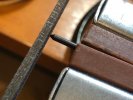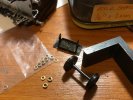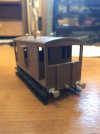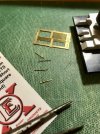End (Fun &) Games
The Dia. 1/211 PALVAN now awaits transfer to the Watkins Wharf Finishing Shop, where it will be given its identity before being subjected to the inscrutable gaze of the LMR Traffic Manager (East London). We’ll try not to point out the vagaries of the corner joints - purely a matter of manufacture, rather than any ineptitude from the Fabrication Shop Boys.
But before the end, a last hill to climb.. vis, the rectification of a non-parallel axle…Having built the van body to sit flat on the bottom of its cast W irons, we were horrified to find that the holes for the bearings on one axle didn’t line up, and made one wheel sit up clear of the railhead. So we made a false floor of 40 thou plasticard, and modified the space (including scraping the back of the axleboxes) for an MJT internal compensating unit, that we made fixed by slipping some 20 thou plasticard either side of the pivot point.

The pinpoint ends of the axle were filed off, and the wheels spaced out from the compensating unit with a variety of Gibson 2mm washers.

The whole assembly was then offered up to the buffer height gauge to determine the thickness of packers required (2 mm). It sits well. A job, jobbed.

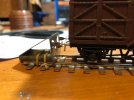
With that hurdle overcome, the last knockings involved a representation of one of the bits that the Keyser PALVAN was light on; the crossbar for the latching of the open door. A bit of 0.3 mm NS round rod flattened with toffee hammer and anvil, and bent to shape. We made one in brass, initially, but it was too soft.

The last last job (we think) was to add the door catch/bang on the relevant corners, and remove the tiebar between the axleboxes. We did this because we weren’t happy with the look of them, and we’ve identified via Larkin’s V2 (A Pictorial Study of the 1955-1961 Period - British Railways Goods Wagons) and Paul Bartlett’s excellent site that Lot 2784 (Summer 1955) were vacuum fitted, but not Clasp, and didn’t have the tiebar. So we took ‘em off. Sue us!
Cheers
Jan

 )
)







